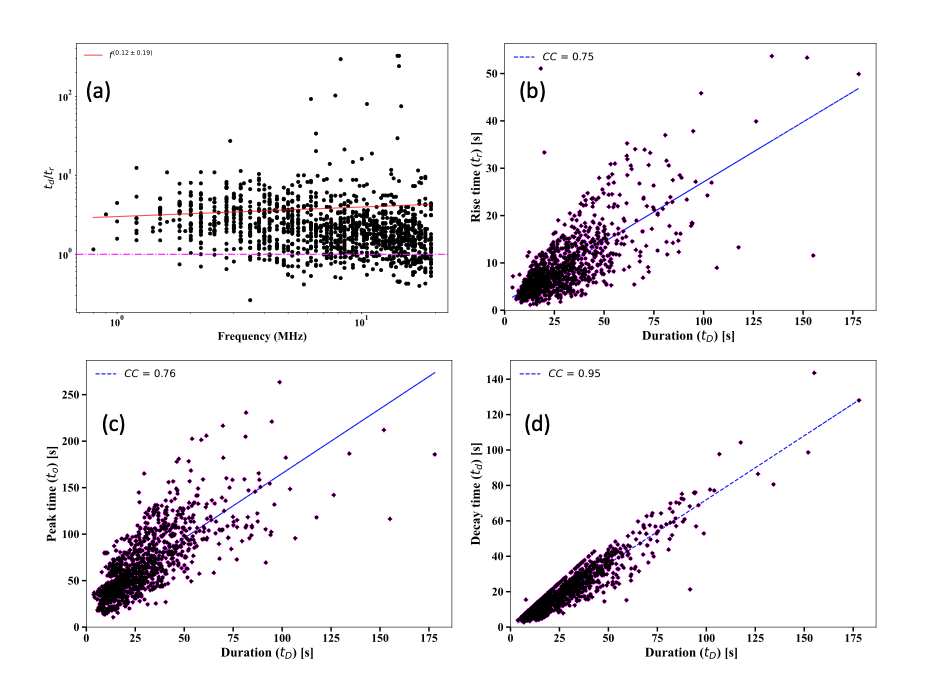Type III solar radio bursts are frequent and powerful radio emissions caused by electron beams travelling through the solar corona into the interplanetary medium, providing valuable information about solar magnetic fields and solar wind dynamics. These bursts are associated with solar flares and indicate indirectly an energetic electron moving along magnetic field lines. This study uses Parker Solar Probe data to examine the time-profile characteristics of type III bursts in the low-frequency domain across different frequency bands, including their rise, peak, and decay times. We have selected 43 well-defined type III bursts, ensuring they were isolated and free from interference and the time profiles were characterized using a bi-Gaussian fitting approach. We investigate the dependencies of these temporal features on frequency and derive insights into burst speeds, bandwidths, and drift rates to understand the underlying physical mechanisms governing type III burst dynamics, aiming to bridge gaps in understanding their temporal and spectral characteristics.
Frequency Independence of Time Asymmetry
Recent studies, notably by Chrysaphi et al. (2024), have underscored the frequency-independent nature of time profile asymmetry in type III solar radio bursts. This discovery is pivotal as it highlights that the physical mechanisms responsible for the generation and propagation of these bursts function uniformly across various frequencies.
The time profile asymmetry, quantified by the ratio of decay time to rise time (td/tr), resulted in a spectral index of 0.12 ± 0.19. This near-zero value indicates that the observed time asymmetry is minimally influenced by frequency variations. Consequently, this suggests that the internal processes within the solar corona and interplanetary medium, which impact type III bursts, maintain consistent characteristics regardless of frequency.
Correlation with Burst Duration
A comprehensive analysis of the burst duration concerning its rise, peak, and decay phases revealed significant correlations, particularly with the decay time. A strong correlation (CC = 0.95) was found between burst duration and decay time, indicating that the decay phase plays a crucial role in determining the overall duration of type III bursts. Further examination showed substantial correlations between burst duration and rise time (CC = 0.75) and between burst duration and peak time (CC = 0.76).

Figure 1: Panels (a) show the asymmetry time profile (td/tr) as a function of frequency. The red solid lines represent the power law fit with their corresponding spectral values shown inside the Panel. Panel (b),(c) and (d) are the scatter plots for the rise, peak and decay time as a function of duration of the burst, respectively. The size of the magenta colour bar represents the standard errors derived from the data’s least square fitting; the blue dashed lines are the best-fitted regression lines.
These correlations highlight that the early phases of the burst, including the rise and peak times, are instrumental in shaping the total duration of the event. The significant correlations with rise and peak times further emphasize the role of initial burst dynamics in shaping the overall duration. These early stages are crucial for setting the conditions for the subsequent burst evolution, influenced by factors like electron beam velocity, density fluctuations, and magnetic field structures.
Conclusion
In conclusion, this study has shed new light on the temporal profiles and underlying physical mechanisms of type III solar radio bursts. The discovery of frequency-independent time asymmetry and the strong correlations between burst duration and decay phase underscores the complex dynamics of electron beams and their interactions with the plasma. These findings significantly impact our understanding of solar-terrestrial interactions and the fundamental processes governing the solar corona and interplanetary space, ultimately contributing to a deeper understanding of the intricate relationships between the Sun and our planet.
Based on the recent paper by Thapa T., and Yan Y., (2024), Time-Profile Study of Type III Solar Radio Bursts using Parker Solar Probe, ApJ, 972, 2, doi:10.3847/1538-4357/ad5e77
References:
- Bale, S. D., Goetz, K., Harvey, P. R., et al. 2016, SSRv, 204, 49, doi: 1007/s11214-016-0244-5
- Chrysaphi, N., Maksimovic, M., Kontar, E. P., et al. 2024, A&A, 687, L12. doi:1051/0004-6361/202348175
- Kontar, E. P., Chen, X., Chrysaphi, N., et al. 2019, ApJ, 884, 122, doi: 3847/1538-4357/ab40bb
- Mann, G., Breitling, F., Vocks, C., et al. 2018, A&A, 611, A57, doi: 1051/0004-6361/201629017
